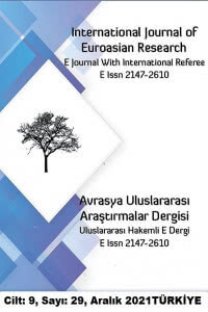SOVYET PROPAGANDA ANİMASYONLARINDA KULLANILAN KAVRAMLAR VE TEMALAR
Bu çalışmada, yaklaşık yetmiş yıllık bir süreçte faaliyetini sürdüren ve sistemli bir mekanizmanın ürünü olarak içinde bulunduğu siyasal ideolojinin etkilerini ve yansımalarını gösteren Sovyet animasyon sinemasının ürettiği kodlar tespit edilmiş, bulunan bulgular doğrultusunda bu animasyon filmlerin Sovyetlerin siyasal tarihini ve toplumsal kültürünü yansıtan bir çeşit kültürel hafıza oluşturduğu irdelenmiştir. Çalışmada, Juliet Corbin ve Anselm Strauss’un nitel verilerin analizi için önerdiği içerik analizi yöntemi kullanılmıştır. Bu yöntemde birbirine benzeyen verilerin belli kavramlar ve temalar çerçevesinde bir araya getirilmesi ve yorumlanması amaçlanmıştır. İçerik analizi dört aşamalı olarak oluşturulmuştur: a) verilerin kodlanması, b) temaların bulunması, c) kodların ve temaların düzenlenmesi, d) bulguların tanımlanması ve yorumlanması. İçerik analizindeki bulgular doğrultusunda bir çerçeve oluşturulursa incelenen filmlerde "biz" ve "onlar" olarak iki ayrı grup oluşturulduğu, "onlar" anlatımının da iki unsur üzerine kurulduğu görülmüştür. Bunlar kapitalizm ve emperyalizm bağlamında oluşturulan Batı karşıtlığı ile faşizm bağlamında oluşturulan Nazi karşıtlığıdır. "Biz" anlatımı ise sosyalizmi ve komünizmi ön plana çıkarma, yayma ve kökleştirme üzerine kuruludur. Bu çerçevede veri olarak kullanılan filmlerin üç ana başlıkta birleştirilebileceği görülmüştür. Bu başlıklar "Kapitalizm ve Emperyalizm Karşıtı Filmler", "Faşizm Karşıtı Filmler" ve "Sosyalizm ve Komünizm Övgüsü İçeren Filmler" olarak tespit edilmiştir. Bütün elde edilen bulgular ve yapılan çıkarımlar üzerinden düşünüldüğünde animasyonların, anlatıldığı ya da referans gösterdiği dönemi yansıtan belgeler olduğu görülmüştür. Bu açıdan bakıldığında Sovyetler Birliği'nin yaptığı propaganda faaliyetleriyle sadece mevcut siyasal fikirlerin ve ideolojilerin gelişmesini ve kalıcı olmasını sağlamadığı, ayrıca toplumda bir bellek ve kültürel hafıza oluşturduğu da söylenebilir.
CONCEPTS AND CATEGORIES USED IN SOVIET PROPAGANDA ANIMATED FILMS
In this research, the codes produced by the Soviet animation cinema, operating for nearly seventy years and showing the consequences and reflections of the political ideology it is involved in as the product of a systematic mechanism, have been determined. In line with the conclusions, it has been examined that these animated films form a kind of cultural memory that reflects the political history and social culture of the Soviets. The content analysis method proposed by Juliet Corbin and Anselm Strauss for the analysis of qualitative data was used in the article. This method aims to gather and interpret similar data within the framework of specific concepts and categories. Content analysis was created in four stages: a) coding of data, b) finding categories, c) organizing codes and categories, d) defining and interpreting findings. If a structure is formed in line with the decisions, it is perceived that two separate groups are created as ‘we’ and ‘they’ in the films analyzed, and the expression ‘they’ is based on two elements: anti-Westernism built in the context of capitalism and imperialism, and anti-Nazism within the connection of fascism. The expression ‘we’ is based on bringing socialism and communism to the forefront, spreading and rooting them. In this connection, it has been noticed that the films used as data can be combined under three main titles: ‘Anti-Capitalist and Anti- Imperialist Films’, ‘Anti-Fascist Films’, and ‘Films with Praise for Socialism and Communism’. After considering all the findings and inferences made, it was comprehended that the animated films were documents that exhibit the period in which they were described or referenced. From this point of view, it can be assumed that the propaganda actions carried out by the Soviet Union not only ensure the development and persistence of existing political ideas and ideologies but also found a cultural memory in the society.
___
- Animator.ru, “фильмы за 1912”, http://www.animator.ru/db/?p=films&year=1912 Last Accessed: December 10, 2020.
- BALINA, Marina & BEUMERS, Birgit, (2015), “To Catch Up and Overtake Disney? Soviet and Post-Soviet Fairy-Tale Films”, Zipes, J.; Greenhill, P. & Magnus-Johnston, K. (Ed.), Fairy-Tale Films Beyond Disney, New York: Routledge.
- BENDAZZI, Giannalberto, (1995), Cartoons: One Hundred Years of Cinema Animation, Indiana University Press.
- BORSTEN, Joan, (Director), (1997), The Animated Soviet Propaganda: From the October Revolution to Perestroika [DVD].
- EISENSTEIN, Sergei, (1982), Film Essays and a Lecture, New Jersey: Princeton University Press.
- İNCEOĞLU, Çağrı, (2013), “Sovyet Propaganda Animasyonlarında Batı ve Batılı İmgesi”, Galatasaray Üniversitesi İletişim Dergisi, S. 19: s. 23-40.
- КАПКОВ, Сергей, (2006), Энциклопедия Отечественной Мультипликации, Москов: Алгоритм-книга.
- Лента, (2005), “Роспечать Выделяет На Социально Значимые Медийные Проекты 470 Миллионов”, 21.04.2005, https://lenta.ru/news/2005/04/21/fapmc Last Accessed: November 24, 2018.
- РОМАШОВА, Мария Владимировна, (2011), “От Истории Анимации К Истории Детства В Ссср: Постановка Проблемы”, Вестник Пермского Университета: История, Выпуск: 3, 114-119.
- РЯБОВ, Олег Вячеславович, (2018), “Как Хорошо, Что Наяву Я Не В Америке Живу!: Образ Сша В Гендерном Дискурсе Советской Мультипликации (1946- 1963)”, Женщина В Российском Обществе, 2, p. 89-103. https://doi.org/10.21064/WinRS.2018.2.8
- ROTHA, Paul, (1930), The Film till Now a Survey of the Cinema, London: Jonathan Cape Thirty Bedford Square.
- STRAUSS, Anselm & CORBIN, Juliet, (1990), Basics of Qualitative Research: Grounded Theory Procedures and Techniques, Newbury Park: Sage Publications.
- TAYLOR, Richard, (1998), Film Propaganda: Soviet Russia and Nazi Germany, New York: I. B. Tauris.
- Центральный Комитет, (1949), “План мероприятия по усилению антиамериканской пропаганды на ближайшее время”, https://www.alexanderyakovlev.org/fond/issues-doc/69577 Last Accessed: December 30, 2020.
